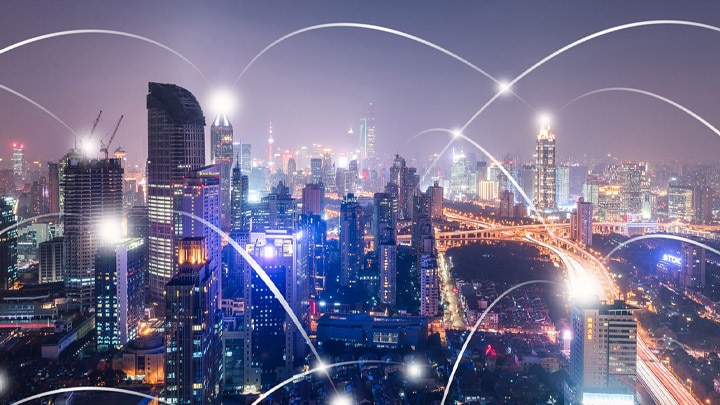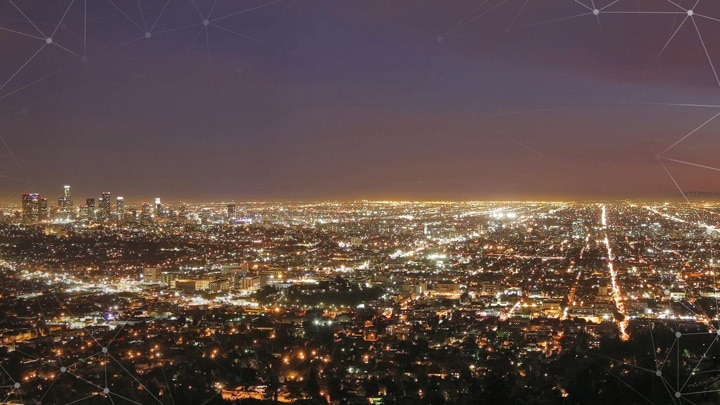On light poles around the world, a readymade smart city infrastructure is springing up. As cities upgrade to connected street lighting, they’re exploring how they can use this infrastructure to improve traffic, save energy and keep people safe. With sensors on light poles offering so many ways to transform city life using the new connectivity on our streets, it’s a great time for sensor and network providers to join forces and deliver integrated smart city solutions.
New partnerships
Smart city technologies bring together devices and networks in new ways – for example, using radar technology sensors and mobile location analytics (MLA) technology to measure vehicle and foot traffic. So it makes sense that new partnerships are needed to take advantage of what’s shaping up to be a significant growth industry. To give you an idea of the opportunity, the global smart pole market is projected to grow 13.7% annually through 2022, with sensors bringing in more than US$1 billion of revenue over that period.
So what do you need to do? If you’re a local network provider who supplies backhaul for connected street lights, make it easy for sensors to connect to your networks. If you’re a sensor company, teaming up with network providers and application developers is a great idea. Together, you can unlock new value by finding ways to surface city data collected by sensors at light points to the people who need it.
A standardized foundation
Fortunately for companies keen to move into this space, the standards authorities are already doing the groundwork to enable this smart city vision to take off. As we speak, the Digital Illumination Interface Alliance (DiiA) and Zhaga are working on a standard for multiple nodes on a light pole: think a top-mounted sensor-ready (SR) luminaire with an extra node mounted facing down the pole. When this standard goes live in the summer time frame, connected lighting will provide a standardized foundation for multi-sensor data collection, supporting both the SR node plus a standard interface for smart city devices. In the meantime, until the standard has materialized, any sensor solution in combination with NLC must be tested and approved by the NLC supplier.
Plug and play
Whether you’re a sensor specialist or a network specialist, the new multi-node standard is exciting news, because light poles with plug-and-play connections offer a readymade foundation for IoT innovation. Sensors can be plugged straight into the pole to tap into the power and network connections they need to gather and send data over the wire ¬– much as a smartphone might connect to a USB port in a car to provide new experiences and services to drivers. Cities can easily add sensors wherever they have lighting, spurring development of citywide IoT networks. So what sensing capabilities will cities add to their light poles? And how can you innovate to make city sensors work harder for citizens?
Radar technology sensors
Already a mature technology used by highway police, radar sensors on light poles have a big role to play in cities’ intelligent transportation systems (ITSs) and traffic management systems. By feeding real-time data about travel speeds into an ITS, radar sensing can help make transport systems safer and more efficient. Traffic engineers can use this data to monitor travel times and traffic hotspots, adjusting traffic light schedules and speed zones to reduce traffic jams and vehicle emissions. City authorities can use this intelligence to guide investment in congestion-busting initiatives that decrease citizen commute times.
Detecting smartphones
Light pole-mounted sensors can also detect smartphone Wi-Fi signals and relay the information to an MLA system. With each smartphone having its own media access control (MAC) address, people in an area can be counted and their movement analyzed, allowing cities to compute crowd sizes, activity in a location and even traffic speeds. This can help authorities improve public safety and traffic flow. Cities can also use this information to understand how residents and visitors use urban space – like the city of Enschede, in the Netherlands, which is using smartphone detection to learn how often people visit and where they go.
Streetlights that dim
Both these technologies can be used to make streets safer and save energy at the same time. Radar sensors can detect cars, bikes and pedestrians and instruct lighting to brighten as they approach and dim as they pass, delivering optimal visibility precisely when needed. Using this approach, the municipality of Hole, in Norway, estimated future savings of 70-80% on low-traffic roads. Another way to achieve the same effect is street lights that switch on only when they sense a smartphone coming. Whatever approach is chosen, there are wider benefits for people and the planet as dimmer lighting reduces sky glow, which disrupts human sleep and the activities of wildlife.
Learn more about the future of outdoor sensors and IoT in our video interview with Jaap van der Linden. And if you have ideas about where the big opportunities for smart city sensors lie, let us know in the comments.
“Whether you’re a sensor specialist or a network specialist, light poles with plug-and-play connections offer a readymade foundation for IoT innovation.”

Global Product Manager
Signify

Lights down, savings up
Wasted energy is hugely expensive for homes, businesses, governments, and the planet. And yet the solution is remarkably simple.

In a connected world, what happens to lighting?
Digital connectivity is changing the world around us. Take the television. Only a few years ago, complex rating systems determined which shows were popular with which audiences.

Let’s play component roulette
City authorities drove one of the fastest technology shifts when they upgraded street lighting to LED. Can digital fingerprints solve this problem?